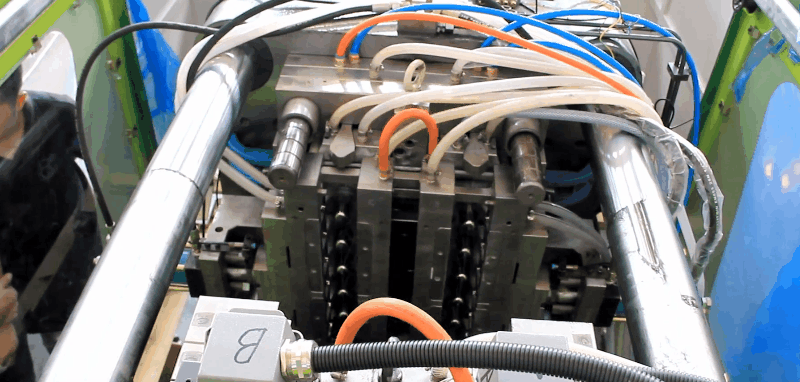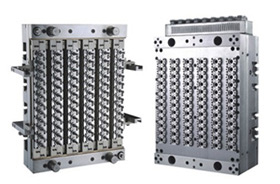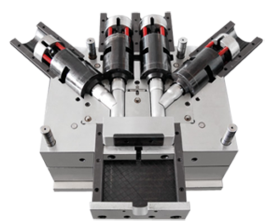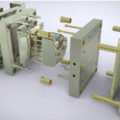External Heating of Injection Cylinder – By Zafar Kamal All injection-moulding machines make use of electrical heaters to aid in the plastification of the material being processed. The most common system uses mica heater bands of high wattage. Actually, several of these heaters are used per zone on the injection cylinder and, depending upon the size of the machine, the total wattage available for heating can be quite substantial. Each zone along the length of the barrel is individually control by the thermocouple and a pyrometer. The thermocouple senses the temperature developed within the zone and transmit the information to the controlling pyrometer. When the temperature reaches the set point of the pyrometer, a signal is generated which tells the heater control to cut off the supply of electricity to that set of the heater bands. Likewise, when a given zone is indicated as being below the preset temperature level, a signal calling for a heat is sent back and the power is again applied to the heating bands. There are a number of suitable instruments commonly used sense temperature
Read more →– By Zafar Kamal Thermodynamics principle are also valid for plastic materials, which are basic to the chemical structure of each. In the melting of various thermoplastics the quantity of heat required per unit weight may vary significantly depending upon the differences in the heat capacity of the various plastics. Every material has a specific heat, which expresses its ability to absorb or release heat energy. Specific heat is the ratio of heat needed to elevate one pound of material one degree to that for heating water, which has a specific heat of 1, expressed as the number of BTU per pound per degree . Due to complexity in handling specific heat data in calculation of heat input and removal, a mathematical extrapolation, heat content, may be used instead. The crystalline melting points for some materials can be seen by the change in the slope of the curves, making it obvious that a great quantity of heat is required to change the plastic’s state from solid to liquid with the little change in temperature. The more crystalline materials require a
Read more →Injection and Charge Controller Setting on Injection Molding Machines [1] Setting of charge stroke [LS5] Set necessary data matched to injection weight on [LS5] (charge out position) on the [INJECT] screen of INJECTVISOR. Set value is obtained by the required stroke calculated from product weight (W) added with 5 mm [0.2 in] of cushion amount. Setting value: 1) Touch the [INJECT] screen selector button and the [INJECT] screen change button, to display the [INJECT] screen. 2) Touch [LS5] (charge out) switch on the [INJECT] screen to open the [LS5 CHARGE COMPLET POS] window. 3) Set the prescribed value on the window. [2] Setting of melt decompression amount [LS10] Set melt decompression amount [LS10] to the minimum value where resin will not leak from the nozzle if an open nozzle is utilized. 1) Following the setting of [LS5], touch [LS10] (melt decompression amount) switch on the [INJECT] screen to open the [LS10] window. 2) Set 2 – 3 mm [0.08 – 0.12 in] of melt decompression amount in the step switch on the window. [3] Setting of melt decompression speed VSB
Read more →Modification of Barrel Temperature control on Injection Molding Machines [To the users of the IS-E, IS-F, IS-G, IS-GN, and EC series] The temperature control structure has been partially modified for the EC-N series and the subsequent series (EC-NII, EC-S/SX and EC-SXⅡ). Understand the following change and different temperature distribution before attempting to adjust the temperature conditions. [Precautions for Barrel Temperature (i1, i1.5, i2)] To attain smooth barrel temperature distribution, this machine has the barrel temperature detect position changed from that of conventional machine as shown in the figure below. This change results in no change to molding conditions. When using resin with high melting latent heat (for example, olefine-based resin) or it is necessary to attain barrel temperature distribution close to that in production with a larger charge stroke of conventional machine, however, we recommend to correct H3 temperature according to the table below. [Precautions for Hopper Throat Temperature (i1, i1.5, i2] Note that since this machine has the hopper throat temperature changed from the conventional machine, its detect position is different from that of the conventional machine. To change
Read more →Nozzle Selection, Assembly and Disassembly of Toshiba Injection Molding Machines (1) Nozzle selection of Toshiba Injection Molding Machines In general, select a nozzle with the curvature radius (RB) of nozzle tip smaller by 1 mm (0.04 in) than the curvature radius (RA) of sprue bush, and nozzle diameter (fD) smaller by 0.5 mm (0.02 in) than the diameter (fC) of sprue bush. Be sure to use only the nozzle and set bolts specified by us. (2) Nozzle assembly and disassembling of Toshiba Injection Molding Machines When disassembling and assembling the nozzle, handle the nozzle, barrel and heater cover with extreme care since hot. Removing the nozzle or end cap with resin left inside the barrel may cause resin to gush out. Close the hopper shutter and repeat charge and injection to thoroughly purge resin out of the barrel before disassembly work. Be sure to wear proper protection tools before working. Follow the procedure below to assemble or disassemble the nozzle. Refer to the construction drawing of the plasticizing parts containing the nozzle on the next page. Refer to STE 83543,
Read more →Noise level of Toshiba Injection Molding Machines Average noise level at the following measuring conditions exceed 70 dB (A), so take protective measures such as wearing earplugs as needed. 【Measuring condition 1】 Height from the floor: 1200 mm (47.2 in). Distance from the safety gate: 1000 mm (39.4 in) No resin operation at maximum settings of Injection speed, Mold opening/closing speed and Screw rotation speed. (Standard specifications) 【Measuring condition 2】 Height from the floor: 1500 mm (59.1 in). Distance from the safety gate: 1000 mm (39.4 in) No resin operation at maximum settings of Injection speed, Mold opening/closing speed and Screw rotation speed. (Standard specifications) Feel Free to Contact Us if Any Questions
Read more →Preparation for Operation on Toshiba Injection Molding Machines 2.1 Precautions for Initial Power ON Check the following before turning the power on for the first time. 1) Check if circuit breakers matched to the inverter are installed. 2) Check if the power and earth lines are securely connected. If three phases (R, S, T) of power input are reversed, the mold thickness setter and injection unit will move to the wrong direction possibly causing an unexpected accident or breakage of the mechanism. 3) Check the cooling water line for a secure connection or no leakage. 4) Check if covers are securely attached. 5) Check if peripheral equipment is securely connected. 6) Check if the installation space around the machine is ample. 7) Check if the machine area is clean and free of unnecessary items, and tools and materials are set in places. 2.2 Inspection Prior to Starting Operation [1] Cooling water check Check that cooling water is flowing under the hopper by observing the flow checker located on the non-operation side of the machine. 2.3 Starting the Machine [1] Power
Read more →Sprues of Plastic Injection Molds The sprue is the channel along which the molten plastic first enters the mould. It delivers the melt from the nozzle to the runner system. The sprue is incoporated in a hardened steel bush which has a seat designed to provide a good seal with the nozzle. Since it is important that the sprue is pulled out when the mould opens and there is a sprue pulling device mounted directly opposite the sprue entry. This can take many forms but typically it would be an undercut or reversed taper to provide a key for the plastic on the moving half of the mould. Since the sprue, like the runner system, is effectively waste it should not be made excessively long.
Read more →Runners of Injection Molds The runner is the flow path by which the molten plastic travels from the sprue (i.e. the moulding machine) to the gates (i.e. the cavity). To prevent the runner freezing off prematurely, its surface area should be small so as to minimize heat transfer to the mould. However, the cross sectional area of the runner should be large so that it presents little resistance to the flow of the plastic but not so large that the cycle time needs to be extended to allow the runner to solidify for ejection. A good indication of the efficiency of a runner is the ratio of its crosssectional area to its surface area.
Read more →Different Features of Injection Molds Gates: The gate is a small orifice which connects the runner to the cavity. It has a number of functions. It provides a convenient weak link by which the moulding can be broken off from the runner system. In some moulds the degating may be automatic when the mould opens. The gate also acts like a valve in that it allows molten plastic to fill the mould but being small it usually freezes off first. The cavity is thus sealed off from the runner system which prevents material being sucked out of the cavity during screw-back. Small gates are preferable because no finishing is required if the moulding is separated cleanly from the runner. So for the initial trials on a mould the gates are made as small as possible and are only opened up if there are mould filling problems. In a multi-cavity mould it is not always possible to arrange for the runner length to each cavity to be the same. This means that cavities close to the sprue would be filled quickly
Read more →Control Station of Injectvisor on Toshiba Injection Molding Machines [1] INJECTVISOR-S51 Injection, Charging, Clamping and Ejector setting can be set on the touch panel. ※For details, refer to the instruction manual “INJECTVISOR-S51”. [2] Operation Controller Machine operation such as Injection, Charging, Clamping and Ejection can be made by using push-buttons directly. Followings are the meaning of each button. Feel Free to Contact Us if Any Questions
Read more →Main Unit and Equipment of Toshiba Injection Molding Machines 1. Outline of Injection Molding Machine The injection molding machine, provided with full electric control system with the use of AC servomotors as the drive source for injection and clamping, operates MANUALLY, SEMI-AUTOMATICALLY or AUTOMATICALLY. The machine can be applied to various types of thermoplastic resin to produce high-quality molded products. The machine operates at high-speed cycle rate while assuring high accuracy on products, energy saving, low operation side, and clean environment. The machine also assures the safety strongly, such as preventing mold closing mechanically as well as interrupting the electric circuit of clamp unit upon opening of the safety gate. 1.1 Main Unit and Equipment The machine is full-type electrically driven injection molding machine equipped with four units of AC servomotors for injection, charging (screw running), ejection and mold opening/closing. The machine is also equipped with geared motors for die height adjustment and nozzle touching. Feel Free to Contact Us if Any Questions
Read more →






